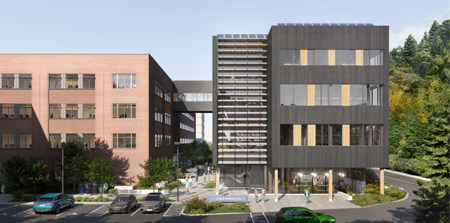

Western Washington University, Kaiser Borsari Hall
Perkins&Will
Western Washington University’s (WWU) new 5,000 m² Electrical Engineering and Computer Science Building represents a significant advancement in sustainable architecture. This groundbreaking facility is poised to be the first higher education STEM building in the United States to pursue both Zero Energy and Zero Carbon certification through the International Living Future Institute (ILFI). Utilizing a mass timber/CLT structure and designed to ILFI’s “smart building” standards, the facility underscores WWU’s commitment to becoming the state’s first carbon-net-neutral university campus. STEM for Everyone The establishment of this facility is driven by WWU’s growing STEM enrollment and Washington’s strategic goals to broaden access to science, technology, and engineering education. It unites the newly formed Electrical Engineering Department and the Computer Science Department under one roof, fostering multidisciplinary learning and collaboration. The building features collaborative hubs, teaming spaces, and offices that facilitate interaction between industry experts, faculty, and students. This dynamic environment promotes innovation, diversity, and inclusion, furthering WWU’s mission of educational excellence and community engagement. Resilient Economic Drivers A key strategy for reducing carbon emissions and enhancing economic resilience is the building’s full electrification, achieved by disconnecting from the campus steam plant. As the electric grid increasingly incorporates renewable energy sources, this approach minimizes the need for carbon offsets and leverages a more economically stable energy resource. By connecting the new facility to an existing building, the project minimizes both costs and carbon impact. The design includes a raised bridge that preserves natural pathways for insects and animals, and the use of durable wood promotes circular design through material reuse. Regenerating the Site and Biophilia Transforming a former parking lot into an eco-friendly building, the project is located east of the Communication Facility building and west of East College Way. It features a landscape of native and climate-adaptive plants, seamlessly integrating with the Sehome Hill Arboretum. This connection creates a habitat bridge, enabling bearers, pollinators, and foragers to move between the arboretum and the campus. Inspired by the arboretum, the building employs biophilic design strategies that harmonize the natural and built environments. Natural materials, the use of green color schemes, and visual connections to nature are integral to reducing stress and enhancing productivity for users. This thoughtful design not only supports the well-being of the campus community but also reinforces WWU’s dedication to sustainability and environmental stewardship.